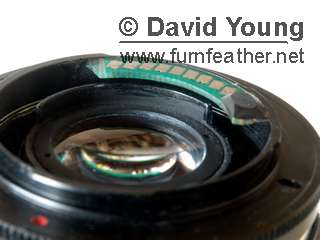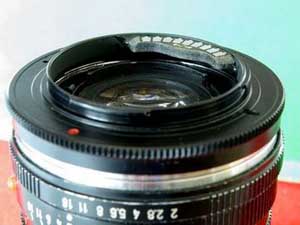| The
Troubles with Adapters: The Russian-made "Dandelion" chip
shows a few foibles, while the Chinese-made
AF-confirm chips/adapters suffer real
problems when using Leica lenses on the Olympus E3. |
||||||||||||||
| The Russian "Dandelion" Chip. | The Shanghai Specials. | |||||||||||||
|
The Dandelion Chip holds great promise. It offers the ability to gain Focus Confirmation with third-party lenses, while giving the correct focal length to the camera, so that the in-body Image Stabilization works properly. The best part is that the Dandelion chip is both thinner and less intrusive into the throat. Thus, it does not have the problems the "Shanghai Specials" have, regarding infinity focus. The 'Dandelion" not only enables AF, by convincing the camera that a Four-thirds lens is attached, it is also programmable, so that it will report the correct Focal Length to the camera, thus ensuring that the IS works properly, too. The chip tells the body that it's a lens with a minimum aperture of f91. It is then easily programmed by shooting a series of photos at f36 though f91... With each shot, the body then sends the lens a command to stop down to a non-existent f-stop. The chip recognizes these commands, making one adjustment to the chip, either focal length or aperture, up or down. Very slick, but it does mean that each lens really needs it's own adapter with pre-programmed chip. However, I have discovered one "flaw" with the Dandelion chip. I tried program it for use with Leica's famous 400mm f6.8 Telyt lens. It worked perfectly, until the camera was turned off, or "went to sleep". With much testing, I discovered that you could remove the chip and reinstall it, providing the camera is on, and it would remember it's settings for days, off the camera and without power. However, if you allowed the camera to "go to sleep", or turn off, while the adapter/lens/chip is attached, it would instantly reset to the default of 50mm/f2. I returned one of my chips to Moscow and, after some time, was informed that the reason for all of this is rather simple. F6.8 is not a value that is "in" the chip! They suggested using f6.9 (close enough for me!) , which would work ... and it does! Perfectly! They also said that it would take some time to "fix" the problem ... which means, I presume, that you'll see Version 3.1 of the firmware, eventually. Meanwhile, the current Version 3 will work just fine, so long as you set f6.9 instead of f6.8! ----------------------------------------------------- There is, however, still two problem with the Dandelion. The first is when used on a Leica Digilux 3, the adapter causes the camera to freeze up, completely. Operation is restored to normal, with no permanent damage, once the chipped adapter is removed from the camera. The second is that if you put an Olympus 1.4 or 2x converter on your Dandelion equipped lens, the body will not recognize the chipped lens. Instead, it considers the lens to be a third party lens, and selects the IS setting from the menu. However, the focus confirmation does not work. |
These Chinese made chips are supplied, already epoxied to a Chinese-built adapter. Unfortunately, they suffer from several drawbacks, despite their low cost and seemingly effective AF chips. Although AF confirmation is, indeed, enabled, the adapters "trick" the cameras into believing that a 55mm f2 lens is attached. Thus, although the FC will work, just fine, the in-body IS system will not, unless your lens just happens to be a 55mm one! You can, of course, tell your E3 the focal length, via a menu, but that menu setting will only be accessed, by the camera, if it detects that a third-party lens is attached. Of course, the adapter convinces the camera that a 4/3rds lens is attached, so that the Focus Confirmation can work! ... Catch 22. So, essentially, if you get Focus Confirmation, you lose the In-body IS. A second problem is that the FC chip is rather thick and intrudes into the throat of the adapter, causing problems with some Leica lenses.
Above you can see the "lip" or "guard" which protects the rear element of some Leitz/Leica lenses, from scratching, when placed rear-element down.
On some lenses, however, this "lip" is blocked by the Focus Confirmation chip in these Chinese, Leica-R to Four-Thirds adapters. If this happens, the lens will not be able to focus to infinity, while on the adapter. Lenses which do not have this "lip" or "guard" seem not to pose any problem. Please remember: all Leica-R lenses will fit on a 4/3rds camera, via a basic adapter and focus to infinity. It is only the adapters containing the Chinese-made Focus Confirmation chip which may cause a problem, and then, only with certain Leitz/Leica lenses. A list of the Leica lenses which have problems with this adapter can be found here. If you do decide to purchase an adapter with this chip, it's best if you turn IS to OFF. |
|||||||||||||
| The Dandelion's web-page can be found here. | ||||||||||||||
One fault, common to both adapters, is that the locking pin is too small for the slot in Leitz/Leica lenses. Thus, they all tend to have a little rotational "slop". This does not affect infinity focus, but it certainly does affect how one feels about the quality of one's gear. However, the FOTODIOX adapter, supplied with the Dandelion chip is much better, in this regard, than the one supplied with the Shanghai Special. |
||||||||||||||
|
||||||||||||||







